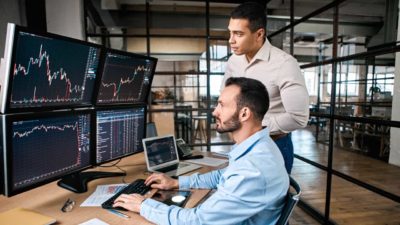1) Even though investors know it's impossible to predict when the market will bottom, it doesn't stop us trying.
Nor does it stop the so-called professionals, including Goldman Sachs.
According to a Reuters report, the investment banking giant – famously described in 1999 by Rolling Stone journalist Matt Taibbi as a "great vampire squid wrapped around the face of humanity, relentlessly jamming its blood funnel into anything that smells like money" – warned the US equity bear market is not over yet.
This is despite the S&P 500 having rallied 10% off its recent lows, with the ASX 200 index up 11% since the beginning of October. Excerpt:
Goldman Sachs on Monday warned that the global equity bear market is not over as the markets are yet to see a trough in the momentum of global growth deterioration, a peak in interest rates and valuations lowered to reflect a likely recession.
"We continue to think that the near-term path for equity markets is likely to be volatile and down before reaching a final trough in 2023", Goldman Sachs said in a note.
2) According to the Australian Financial Review, Morgan Stanley equity strategist Chris Nicol has set an ASX 200 index target at 7200 with a total return of 7 per cent. Excerpt:
The range of outcomes is wide with a bullish forecast of 8100 or a 20 per cent return and a bearish forecast of 5900 or a negative 11 per cent return.
The firm is overweight energy, healthcare and diversified mining companies, and underweight banks, housing and consumer stocks.
"2023 looms as a year of peaking signals and stress. Australia lags in terms of tightening impact, with earnings and activity still to adjust. Index target [is] seen at 7200," Mr Nicol says.
At the close of trade on Tuesday, the S&P/ASX 200 Index (ASX: XJO) finished at 7181, almost bang on the target set by Morgan Stanley.
It seems Nicol is banking on the big dividends from the likes of BHP Group Ltd (ASX: BHP), Rio Tinto Ltd (ASX: RIO), and Woodside Energy Group Ltd (ASX: WDS) continuing into next year to get to his total return target of seven per cent.
3) A trading update today from discount apparel retailer Best & Less Group Holdings Ltd (ASX: BST) makes sombre reading for shareholders like myself. It also delivers pain to shareholders, with the Best & Less share price plunging more than 13% lower to $2.35. Excerpt:
After reporting +38.0% total sales growth for the first eight weeks of FY23, sales growth has since moderated, reflecting the delayed start to summer weather and supply chain delays.
While unaudited year to date (YTD) earnings to the end of October are in line with the prior corresponding period (PCP), a significant increase in sales growth from current levels is required to maintain this result for the first half.
Last week, I named Best & Less as "one consumer discretionary stock I'm playing for the coming economic slowdown".
Today's update suggests trading has fallen off a cliff in recent weeks. I'm hopeful it's weather related, although subdued consumer confidence largely as a result of rising interest rates will no doubt have played a role. The big unknown is the competitive threat from the likes of Wesfarmers Ltd (ASX: WES) owned K-Mart, something that will be far more enduring than a bout of soggy weather.
Buying something because it's cheap – Best & Less shares previously traded at less than nine times earnings and on a fully franked dividend yield of over 9.1% – offers some level of downside protection, but not enough to offset a poor trading update and the real possibility that profits will fall.
It's yet another reminder to myself that…
- Investing in the retail sector is incredibly tough, courtesy of the competitive and economic environment.
- You are better to pay up for a quality company with a sustainable competitive advantage – one that can steadily compound earnings for years to come – than buying a mediocre company on the cheap, hoping it will re-rate before the inevitable profit warning.
- Investing is hard.
I'm holding onto my Best & Less shares for now. They are a small position in my diversified portfolio, and I hold out hope that trading will improve in the run-up to Christmas. I'm most certainly not adding to my position – even after today's sell-off, the risks are to the downside for Best & Less shares.
4) Crypto investors are in a world of hurt, with the Bitcoin price down 72% over the past 12 months.
Writing on Livewire, Coolabah Capital's Christopher Joyce says the crypto crash "bears the hallmarks of a standard non-bank financial crisis that inevitably arises every time there is a liquidity shock. Unfortunately, it is likely to get worse." Excerpt:
Non-banks, including many crypto concerns such as exchanges and coins, have almost no regulation and/or scrutiny. And they tend to be murky private businesses, run by anonymous individuals, often located in dubious jurisdictions, that are protected from the reporting demands of public market enterprises.
Most of what we see today in the crypto universe will die. There will surely be some residual winners, and there are doubtless some impressive technological innovations that will sustain. But anything of serious value will likely be absorbed by the traditional banking system. The dominant digital currencies of the future will be those issued and guaranteed by nation states.
As an equities person, I've happily let the whole crypto craze pass me by, not tempted by the once seemingly easy money on offer in months and years gone past. I've had no problems losing money this past year without adding crypto to my list of things to worry about.
Still, I never like to see people losing money, especially those who trusted the now-bankrupt FTX exchange with their crypto assets. They are staring down the barrel of a near-total loss.
I'd warn against trying to bottom-fish the crypto space. The current lack of trust in the asset class combined with a potential liquidity crunch means future returns are highly unpredictable and incredibly risky. There are surely easier ways to make money.
5) That said, Cathie Wood of Ark Investment Management is wading into the space, scooping up shares of struggling cryptocurrency exchange Coinbase Global Inc (NASDAQ: COIN), despite the collapse of Sam Bankman-Fried's FTX.
Wood's Ark Investment Management funds have bought more than 1.3 million shares of Coinbase since the start of November, worth about $56 million based on Monday's trading price, according to data compiled by Bloomberg. The shopping spree, which started just as FTX's demise began, has boosted Ark's total holdings by roughly 19% to about 8.4 million shares. That equates to around 4.7% of Coinbase's total outstanding shares.
The Coinbase share price has fallen almost 84% so far this year, outpacing the 64% fall in Cathie Wood's flagship ARK Innovation ETF. It's been a very tough year for growth investors, crypto and stocks alike.








